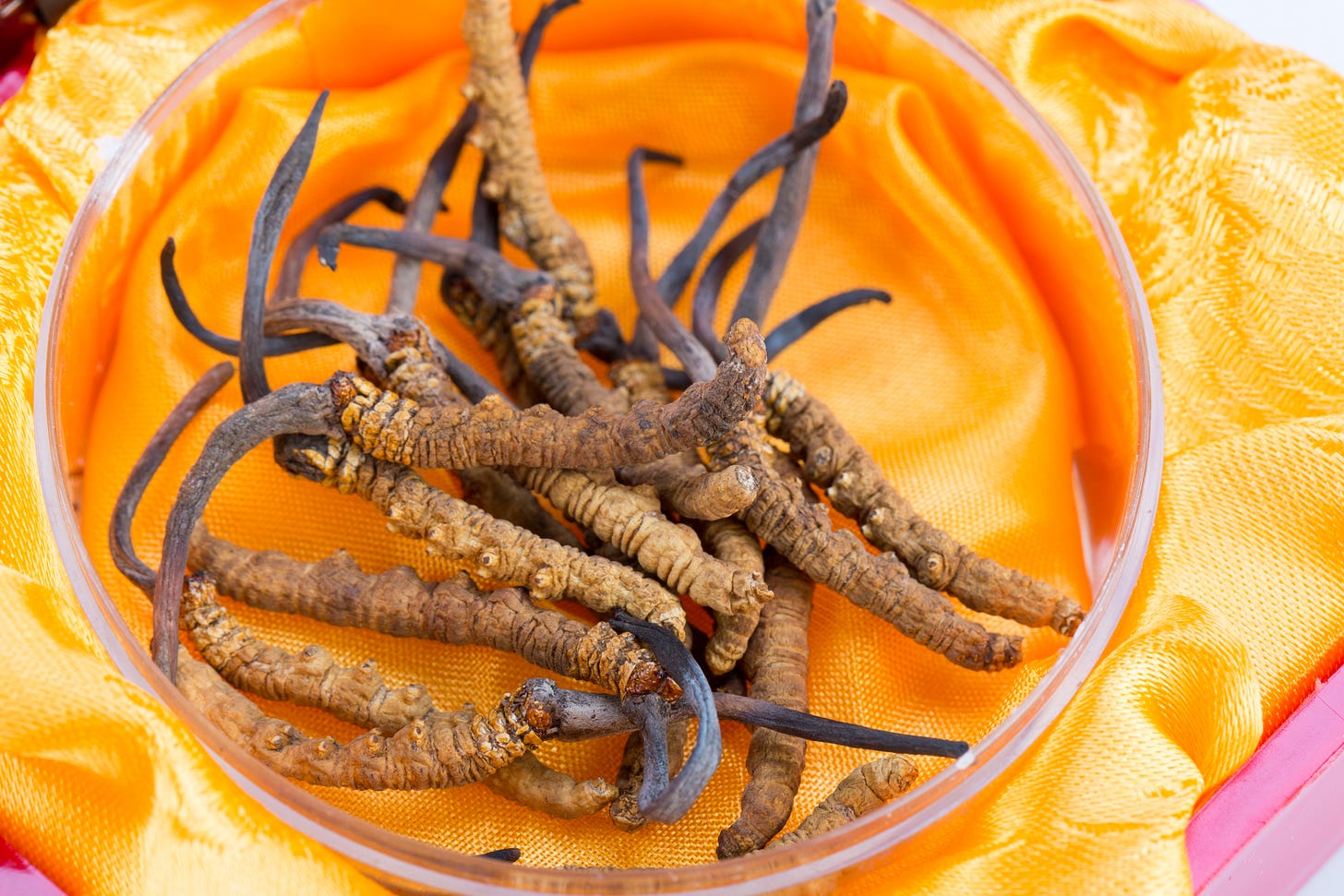On the Tibetan plateau, a fungus thrives. It is found almost exclusively at very high altitude, sometimes over 16,000 feet, and withstands temperatures that reliably drop to -40º C (= -40º F) in the Winter. The fungus, Ophiocordyceps sinensis, is one of the most highly valued traditional Chinese medicines, and has been for centuries. Today, it is used to treat disorders of the kidney, liver, nervous and cardiovascular systems, as well as immunological disorders and cancer. It is also known to be effective against fatigue, which we know in part because mice swim for longer before giving up when they’ve got some O. sinensis in their system1. But this fungus’s most famous tricks are yet to come: it is said to cure impotence, improve sperm count, and enhance libido in both men and women, which give it one of its common names: Himalayan Viagra2.
Himalayan Viagra is of such renown, of such diverse medicinal and commercial value, that it has been proposed as the national fungus of China, as well as “fungus of the year” for the scientific journal Mycology3. I include this only to note how utterly weird the scientific literature sometimes is. National fungus? Fungus of the year? Moving right along…
Himalayan Viagra is also known for a feature of its biology that is more unusual yet. Another name that it goes by is “caterpillar fungus”, as it infects the caterpillars of ghost moths, which live in the soil. The fungus remains latent while the caterpillar continues to eat, presumably unaware of its fate. After several weeks, or even months, of living in what might look like harmony from the outside, the fungus drives the caterpillar close to the surface of the soil, before mummifying it with its own spores, at which point a fruiting body—basically a mushroom—grows from the caterpillar’s head4.
A hidden force subjects the child of the ghost moth to its will, ultimately springing forth from its very head after a period of silent cohabitation. Life finds a way; and so does death.
Perhaps, though, you are yet unconvinced by this story’s relevance to my title. Ghost moths—check. Mummies—check. But zombies? Not so much.
In the next story, I think you will find more evidence of “zombification,” but sensu lato (in the broad sense), rather than sensu stricto (in the narrow sense), a note I hasten to add lest I offend any zombie specialists and/or purists, of which I am neither.
I bring you another cordyceps fungus, this time Ophiocordyceps unilateralis, from Thailand. This fungus reaches into the brains of ants and manipulates their behavior.
Ants of the species Camponotus leonardi, upon being infected by the fungus, climb into vegetation in the tropical forests where they live, stopping at the perfect height at which fungus can propagate. The ants then bite into the vegetation—their jaws clamping down in a grip that does not release upon their death—immediately before the fungus kills them. Shortly thereafter, the fungus erupts from the dead ant’s head5 (this whole clade of fungus seems to have a penchant for erupting from the heads of its victims). The ant lived its last moments fully under the control of a fungus, doing its bidding. No young ant dreams of becoming a zombie, but what is there to be done about it?
How to avoid becoming a zombie? Insects, especially social insects like ants, manage a number of different techniques. They may generate a fever response, which reduces their infectivity. They groom one another to clear pathogenic spores6. They may even be able to smell fungal pathogens, the better to avoid them, or to more quickly clean themselves of an infection7. And if all else fails, they go far away from their home and nestmates and die alone, so as to avoid infecting their family8.
The caterpillar fungus—or excuse me, the Himalayan Viagra—with which I started this piece, would seem to be accustomed, given its parasitic nature, to taking the lead in interactions when some live, and some die. But given its reputed ability to restore potency, and the largely unsuccessful attempts to cultivate it, it is in high demand. The fungus has suffered from overharvesting, its numbers dwindling, its fragile alpine environments devastated by human foragers. But Himalayan Viagra, a mummifying parasite of ghost moths, is not going gently into that good night. It is indirectly responsible for several murders, as local villagers are getting fed up with outsiders making bank on their limited supply, and are taking the law into their own hands9. It’s vigilante justice in service of the harvesting of a mummifying fungus that specializes on the children of ghost moths.
Happy Halloween to all, and to all a good night.
This special Halloween post is in lieu of next Tuesday’s post. See you in nine days!
(For paying subscribers—your audio reads for both this, and yes, the Vitamin D and Covid piece (thank you for all the comments and back-and-forth in my “What is your X?” post from last Wednesday), will drop this week.)
Koh et al 2003. Antifatigue and antistress effect of the hot-water fraction from mycelia of Cordyceps sinensis. Biological and Pharmaceutical Bulletin, 26(5): 691-694.
Belwal et al 2019. Ophiocordyceps sinensis. In Nonvitamin and Nonmineral Nutritional Supplements (pp. 527-537). Academic Press.
Zhang et al 2012. Ophiocordyceps sinensis, the flagship fungus of China: terminology, life strategy and ecology. Mycology, 3(1): 2-10.
Hu et al 2013. Genome survey uncovers the secrets of sex and lifestyle in caterpillar fungus. Chinese Sci Bull 58: 2846–2854.
Andersen et al 2009. The life of a dead ant: the expression of an adaptive extended phenotype. The American Naturalist, 174(3): 424-433.
Shang et al 2015. Fungi that infect insects: altering host behavior and beyond. PLoS pathogens, 11(8), p.e1005037.
Zhukovskaya et al 2013. Grooming behavior as a mechanism of insect disease defense. Insects, 4(4): 609-630.
Heinze and Walter 2010. Moribund ants leave their nests to die in social isolation. Current Biology, 20(3): 249-252.
Again: Hu et al 2013






The Last of Us took this across the bar and made a fortune on it. People just love being frightened!
Happy Halloween!
They're coming to get you, Mothra.